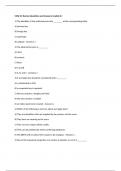Exam (elaborations)
COSC 61 Review Questions and Answers Graded A+
- Course
- Institution
COSC 61 Review Questions and Answers Graded A+ 1) The identifier of the entity becomes the ________ of the corresponding table. A) primary key B) foreign key C) supertype D) subtype - Answers a 2) The ideal primary key is ________. A) short B) numeric C) fixed D) A and B E) A, B, and C -...
[Show more]



